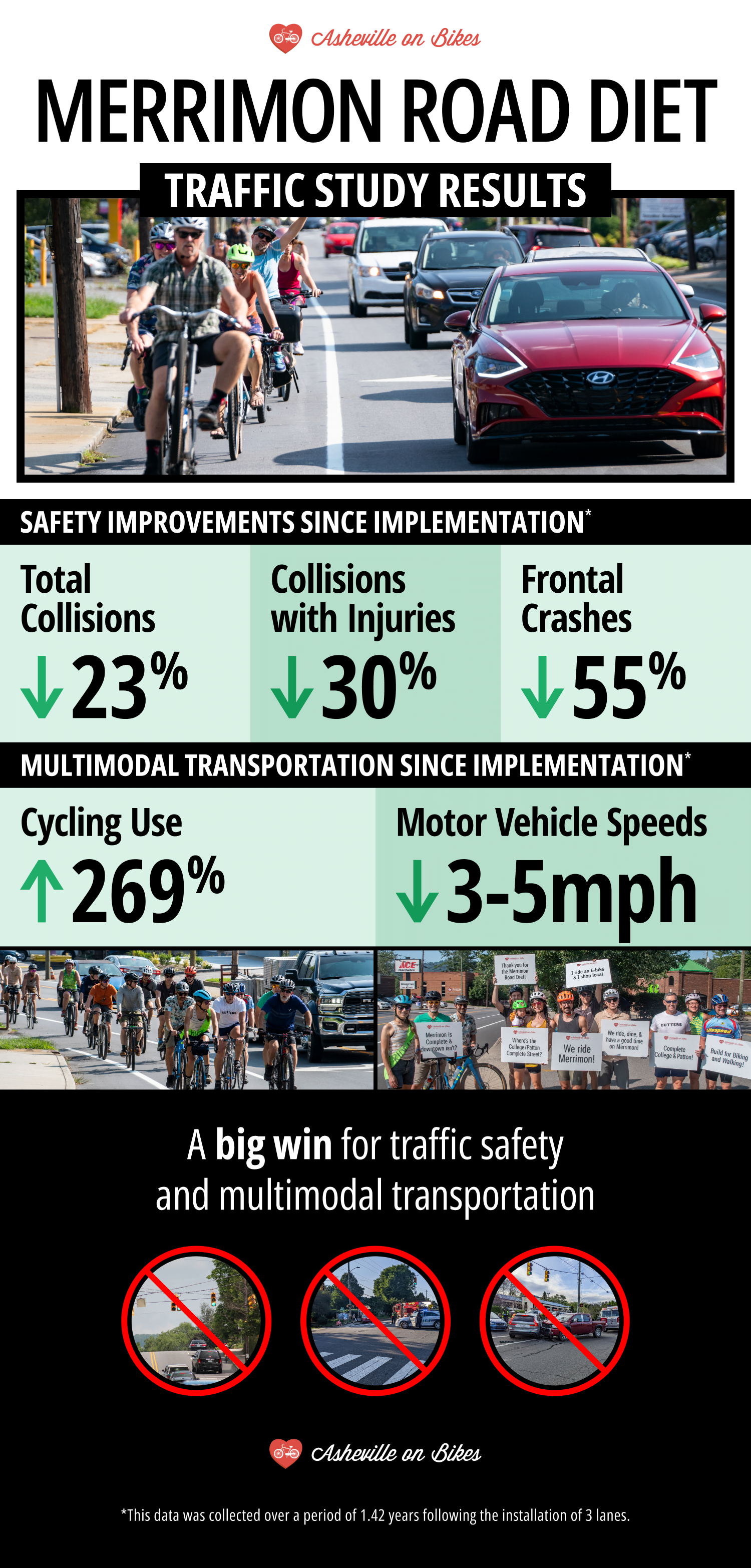Asheville, NC—Asheville on Bikes (AoB) is proud to share the initial results of the Merrimon Road Diet Traffic Study, which demonstrate a significant victory for traffic safety and multimodal transportation on a key roadway connecting downtown and North Asheville. The study analyzed data over a 1.42-year period following the implementation of a new 3-lane traffic pattern, with a center turn lane and dedicated bike lanes, to replace a four-lane roadway. It revealed substantial reductions in collisions, increased cyclist usage, and minimal impacts on vehicle travel times.
“When we first advocated for the Merrimon Road Diet, there were many who doubted its benefits,” said Mike Sule, Executive Director of Asheville on Bikes. “Concerns were raised about potential traffic delays and safety issues for cyclists. However, the data tells a different story. Not only have we seen dramatic safety improvements, but the increase in travel times is negligible—just a few seconds during peak hours. This is a clear example of how thoughtful street design can benefit everyone.”

Key findings of the traffic study include a 23% decrease in total collisions; a 30% decrease in collisions with injuries; a 3-5 mph decrease in motor vehicle speeds; a shift in crash types, with a 55% decrease in front-end collisions; a 269% increase in cycling use on the corridor; and only a minimal increase in travel times for cars, averaging 2-14 seconds.
These findings offer strong evidence in favor of the Merrimon Road Diet and reinforce the value of converting 4-lane roads into 3-lane configurations with dedicated bike lanes. The new traffic pattern has made the Merrimon corridor significantly safer for all road users, particularly cyclists and pedestrians, while maintaining efficient vehicular traffic flow, making it a strong model for future street transformations in Western North Carolina.
The Merrimon Road Diet was intended to improve safety for all users while promoting more sustainable forms of transportation. The results speak volumes: a significant reduction in both total collisions and those involving injuries. The decrease in motor vehicle speeds, coupled with a shift in crash types from more dangerous frontal collisions to rear-end crashes, underscores the effectiveness of the new road configuration.
One of the most striking outcomes is the 269% increase in cycling along the Merrimon corridor. This surge in bike use reflects the growing demand for safe, accessible routes for cyclists in Asheville, and highlights the importance of continuing to invest in infrastructure that supports active transportation.
Contrary to the fears of increased traffic delays, the study found only a slight increase in travel times for vehicles—between 2-14 seconds during peak afternoon hours. This minimal impact on vehicle travel times is a small price to pay for the significant gains in safety and multimodal accessibility.
Sule noted, “As we’ve seen on Merrimon Avenue, a small increase in travel time is more than worth it when it comes to saving lives and encouraging healthier, more sustainable transportation options in our community and beyond.”
The success of the Merrimon Road Diet has broader implications for similar streets across Western North Carolina. Many other 4-lane roads in the region share characteristics with Merrimon Avenue, including frequent curb cuts, commuter traffic, and neighborhood interactions. This study suggests that 3-lane conversions could be successfully implemented on these roads, enhancing safety and accessibility without causing significant disruptions to vehicular traffic.
With a scheduled road resurfacing project on the horizon, Asheville on Bikes is calling on the city to seize this opportunity to further its commitment to complete streets. The Merrimon Road Diet has shown that the right design can create safer, more inclusive streets that serve all users, including pedestrians and bikers.
“We are so grateful to the Asheville residents who supported the Merrimon Road Diet. Your participation and advocacy have helped to make Asheville a safer, more vibrant city for all,” said Sule. “We look forward to continuing our work together to advance sustainable transportation in the community we all love.”
Those who want to learn more about AoB's mission to improve Asheville’s bicycle and pedestrian infrastructure or to get involved are invited to visit their website for more information.
###
For more information about Asheville on Bikes, contact the company here:
Asheville on Bikes
Mike Sule
828-582-4705
ashevilleonbikes@gmail.com
